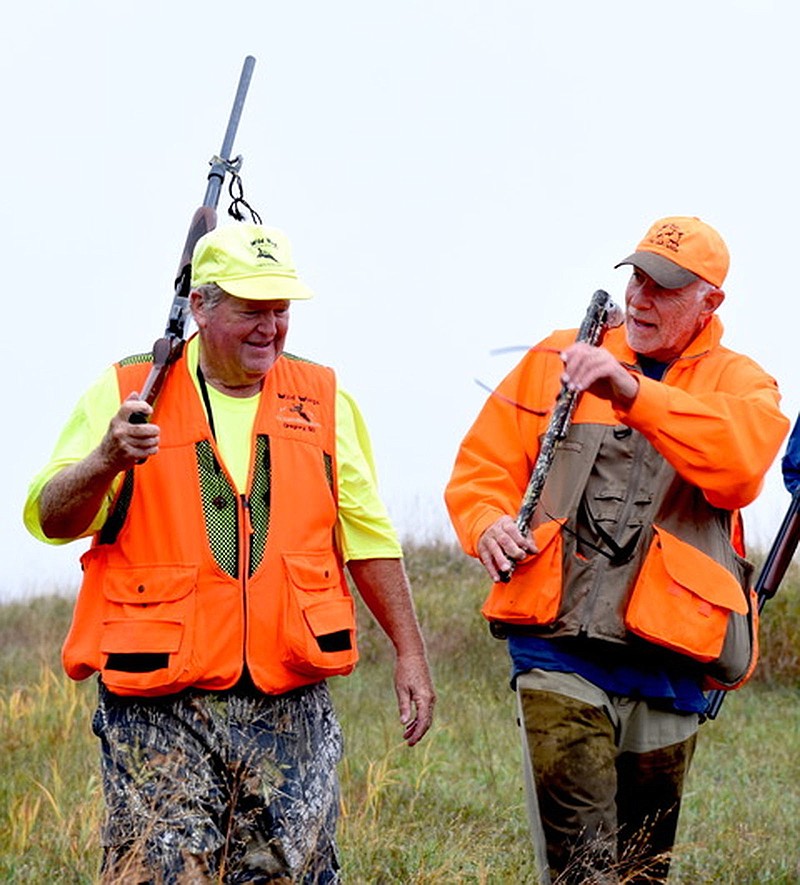GREGORY, S.D. -- The weather forecast for this part of the world was pure fantasy.
It was supposed to be warm and sunny, with highs in the mid 70s all week, perfect for an annual pheasant hunting trip to the self-proclaimed pheasant hunting capital of the world with a group from around the state Oct. 1-3.
The party included federal judge Billy Roy Wilson of Bigelow, Robert "Skip" Henry of Little Rock, Bill Henry of Little Rock, James Riddle of Osceola, Steve Scott of El Dorado, Jim Smith of Little Rock, Mark Wilson of Del City, Okla., federal magistrate judge Joe Volpe of Little Rock, Thomas Mays of Little Rock, John Logan of Blytheville, former state senator David Burnett of Osceola, Joe Thomas of Osceola, James Broglen of Fayetteville, Price Gardner of Roland, Evan Adams of Little Rock, Darrow Jones of Little Rock, Jerry Lovelace of Springdale, Ed Harshmann, James Riddle, Greg Graham of Little Rock, Andrew Graham of Centerton, Matt Henry of Paron, Ford Overton of Little Rock, Ken Reeves of Harrison and Anthony Michael of Little Rock.
The group is the largest ever. That's not surprising coming late in the coronavirus pandemic. Everybody is vaccinated, and everyone is thrilled to be back in circulation again.
The venue is Wild Wings, owned and operated by Jeff Johnson, George Johnson and Gavin Pochop of Gregory County, S.D.. Wilson established the annual tradition more than four decades ago with the late Rick Johnson. This is my fourth visit, and it is one of the best.
Except for the weather.
It was raining when I arrived on Thursday, and it turned the fields and unpaved roads into a slick mire that caked like concrete on boots and made it difficult to access the hunting fields with four-wheel drive trucks.
Before the first hunt, George Johnson warned the group that pheasants would probably fly low in the wet wind, and he implored hunters to be especially careful against taking low shots.
"If somebody chews your butt, it's not because we don't like you," Johnson said. "It's because we have no tolerance for taking low shots."
I brought a couple of really nice over/under shotguns, a Browning Citori Gran Lightning 16-gauge and a Browning Superposed 20-gauge made in 1967. It's a short-tang model that does not have the dreaded "salt" wood that Browning applied to certain models Superposed in the late 1960s. I don't carry nice guns in the rain, so I carried a camera, instead. With my trusty 70-200mm "gauge," I shot more birds than anybody.
Wild Wings is a pheasant preserve, which operates under different regulations than conventional outfits. The operation releases young pheasants into the wild in April, and they mature as wild birds. Preserves are required to release a large percentage of pheasants above the number they expect to kill in a season. They keep meticulous records, tagging and documenting every cock pheasant its hunters kill in a season.
We hunted four fields, the longest of which was a half-mile long. Three fields consisted of a milo field in the center and a cedar shelter belt on one side. There's also a feathered edge on the other side. The youngest, most physically fit hunters form a line to walk through the milo. Most of the pheasants hide in that tall, thick, formidable cover. Two columns of hunters -- flankers -- walk outside the fields in front of the center line. Their role is to shoot pheasants that fly out the sides of the field.
The wariest, wiliest pheasants avoid flying. They run through the cover in front of the battle line, and the wiliest birds of all double back and run safely behind the battle line and the dogs, never offering a shot.
If allowed, "runners" will dash out the end of the field and vanish in safety in the next available cover without ever being seen.
To prevent that from happening, another group of hunters form a blocking line at the end of the field. When pheasants run into the blockers, their only option is to fly, and some epic shootouts often occur when battle line pushes the running birds into the blockers.
Wild Wings uses only Labrador retrievers. Its guides discourage clients from bringing their own dogs. Wild Wings's Labs are driven to run down runners, but they also have the keen noses and the finesse to root out and even point pheasants that burrow into thick cover. They will run a country mile to run down and retrieve a bird that dies after a long flight or a wounded runner.
Intense harassment is a big part of the tradition. If someone takes credit for his own shot, other hunters dispute the boast and claim the bird themselves.
It is forbidden to acknowledge Wilson shooting a bird. Bob Casali of Little Rock, a first-time participant, raved about Wilson making a great shot.
"You can't say that, man!" I said.
"I saw it," Casalli said.
"You must not like hunting here, and you don't want to be invited back," George Johnson said.
"Oh. OH!" Casalli said, getting the message.
I was sanctioned in 2018 for publishing a photograph in this space of Wilson shooting a pheasant. It was widely speculated that the photo was altered.
Another fellow later disavowed having seen Wilson make a killing shot.
"When I tell you something, I really believe it's the truth," he said to George Johnson. "But I realize that sometimes what I believe is the truth might not necessarily be what happened."
"That's exactly how I want you to think," Johnson said.
Through it all, Wilson roared in protest.
The weather cleared on Saturday, and the hunting was spectacular for the rest of the weekend. By all accounts and amended accounts, Wilson finished the hunt without killing a pheasant. The streak is intact since 1973.
